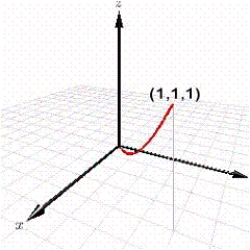A) 6
B) 4
C) 7
D) 9
E) 8
Correct Answer

verified
Correct Answer
verified
Multiple Choice
Determine the interval on which the vector-valued function  is continuous.
is continuous.
A) (9,∞)
B) (5,∞)
C) [5,∞)
D) [9,∞)
E) (-5,∞)
Correct Answer

verified
Correct Answer
verified
Multiple Choice
Uranus moves in an elliptical orbit with the sun at one of the foci.The length of the half of the major axis is 2,876,769,540 kilometers,and the eccentricity is 0.0444.Find the minimum distance (perihelion) of Uranus from the sun.Round your answer to nearest kilometer.
A) 3,004,498,108 km
B) 2,749,040,972 km
C) 2,819,234,149 km
D) 7,819,870,365 km
E) 2,934,304,931 km
Correct Answer

verified
Correct Answer
verified
Multiple Choice
Find the area of the inner loop of  .
.
A) ![]()
B) ![]()
C) ![]()
D) ![]()
E) ![]()
Correct Answer

verified
Correct Answer
verified
Multiple Choice
Find  .
. 
A) ![]()
B) ![]()
C) ![]()
D) ![]()
E) ![]()
Correct Answer

verified
Correct Answer
verified
Multiple Choice
Find the second derivative  of the parametric equations
of the parametric equations  ,
,  .
.
A) ![]()
B) ![]()
C) ![]()
D) ![]()
E) ![]()
Correct Answer

verified
Correct Answer
verified
Multiple Choice
Find r' (t) given the following vector function. 
A) ![]()
B) ![]()
C) ![]()
D) ![]()
E) ![]()
Correct Answer

verified
Correct Answer
verified
Multiple Choice
A particle moves in the xy-plane such that its position for time  is given by
is given by  and
and  .What is the slope of the tangent to the path of the particle when
.What is the slope of the tangent to the path of the particle when  ?
?
A) ![]()
B) ![]()
C) ![]()
D) ![]()
Correct Answer

verified
Correct Answer
verified
Multiple Choice
Sketch the curve represented by the parametric equations,and write the corresponding rectangular equation by eliminating the parameter. 
A) ![]()
![]()
B) ![]()
![]()
C) ![]()
![]()
D) ![]()
![]()
E) none of the above
Correct Answer

verified
Correct Answer
verified
Multiple Choice
The position vector of a particle moving in the xy-plane is  for
for  .For what value of y does the path of the particle have a horizontal tangent?
.For what value of y does the path of the particle have a horizontal tangent?
A) -300
B) ![]()
C) 25
D) 300
Correct Answer

verified
Correct Answer
verified
Multiple Choice
Find  .
. 
A) ![]()
B) ![]()
C) ![]()
D) ![]()
E) ![]()
Correct Answer

verified
Correct Answer
verified
Multiple Choice
Match the equation with its graph. 
A) ![]()
B) ![]()
C) ![]()
D) ![]()
E) ![]()
Correct Answer

verified
Correct Answer
verified
Multiple Choice
A particle moves in the xy-plane so that its velocity vector for time  is
is  .Which one of the following statements is true about the particle when
.Which one of the following statements is true about the particle when  ?
?
A) The particle is speeding up.
B) The particle is slowing down.
C) The particle is at rest.
D) The speed of the particle is ![]() .
.
Correct Answer

verified
Correct Answer
verified
Multiple Choice
Find the arc length of the curve on the given interval. 
A) ![]()
B) ![]()
C) ![]()
D) ![]()
E) ![]()
Correct Answer

verified
Correct Answer
verified
Multiple Choice
Classify the graph of the equation as a circle,a parabola,an ellipse,or a hyperbola. 
A) parabola
B) ellipse
C) circle
D) hyperbola
Correct Answer

verified
Correct Answer
verified
Multiple Choice
Find  given the following vector function.
given the following vector function. 
A) ![]()
B) ![]()
C) ![]()
D) ![]()
E) ![]()
Correct Answer

verified
Correct Answer
verified
Multiple Choice
Match the equation with the graph shown in red below. 
A) ![]()
B) ![]()
C) ![]()
D) ![]()
E) ![]()
Correct Answer

verified
Correct Answer
verified
Multiple Choice
Find the length of the curve over the given interval. 
A) ![]()
B) ![]()
C) ![]()
D) ![]()
E) ![]()
Correct Answer

verified
Correct Answer
verified
Multiple Choice
Use the given acceleration function and initial conditions to find the position at time  .
. 
A) ![]()
B) ![]()
C) ![]()
D) ![]()
E) ![]()
Correct Answer

verified
Correct Answer
verified
Multiple Choice
Find r' (t) given the following vector function. 
A) ![]()
B) ![]()
C) ![]()
D) ![]()
E) ![]()
Correct Answer

verified
Correct Answer
verified
Showing 121 - 140 of 173
Related Exams